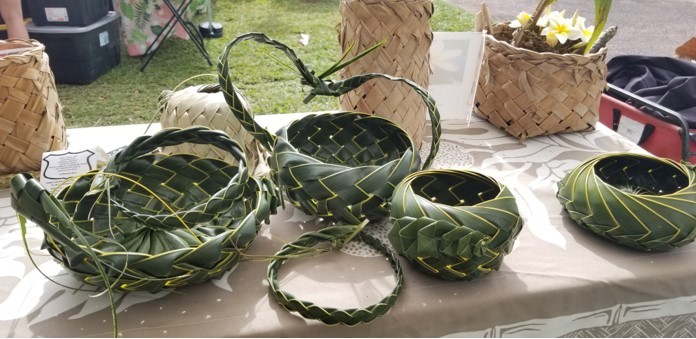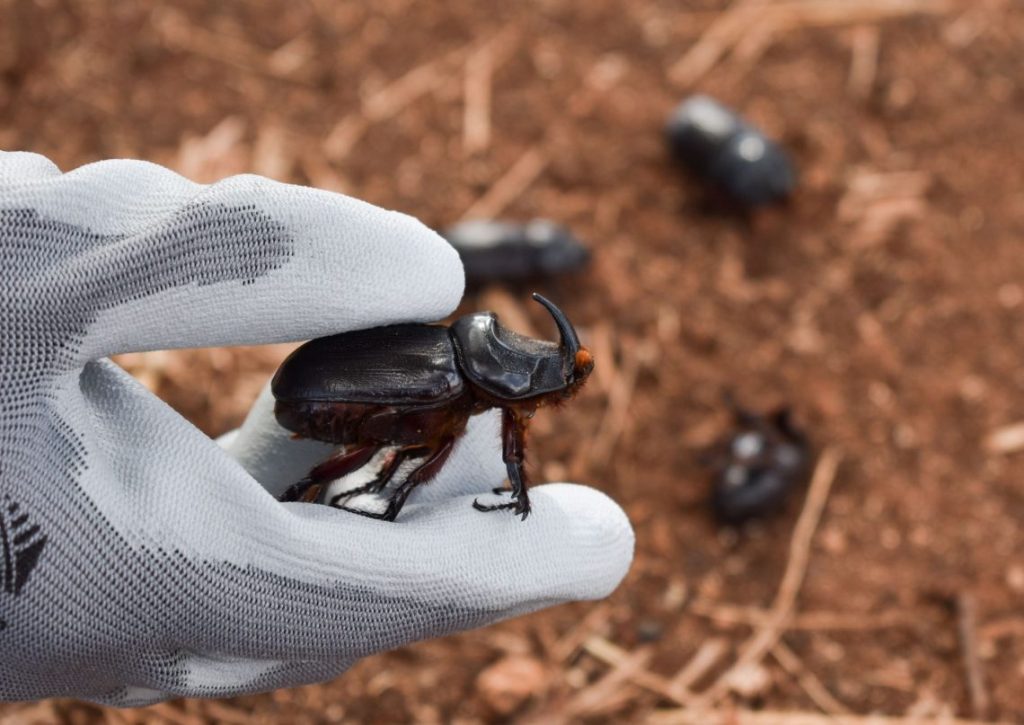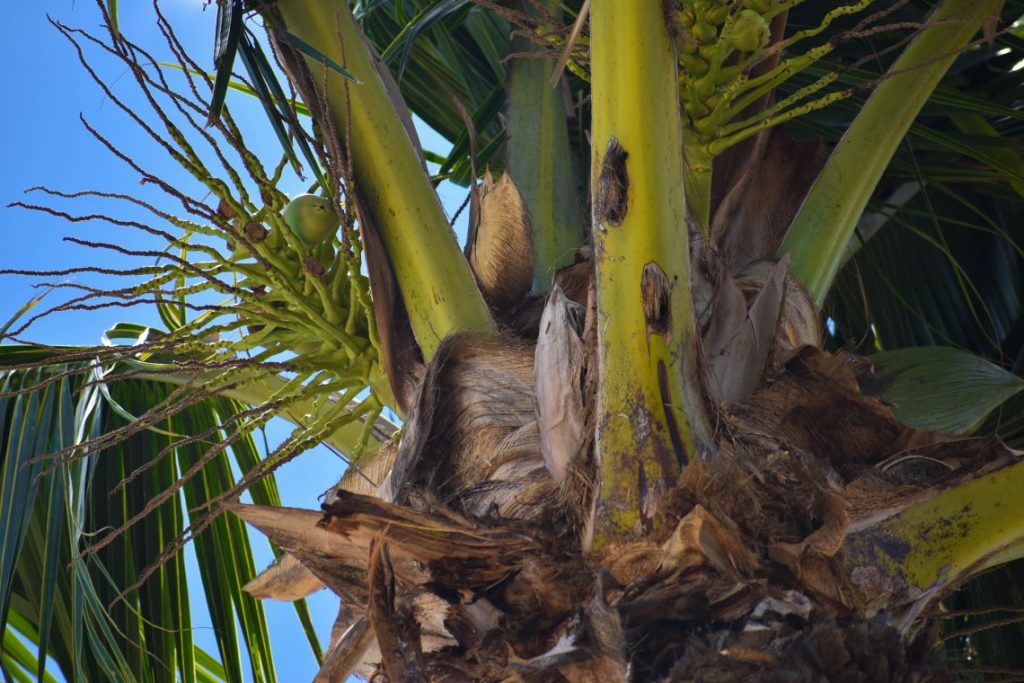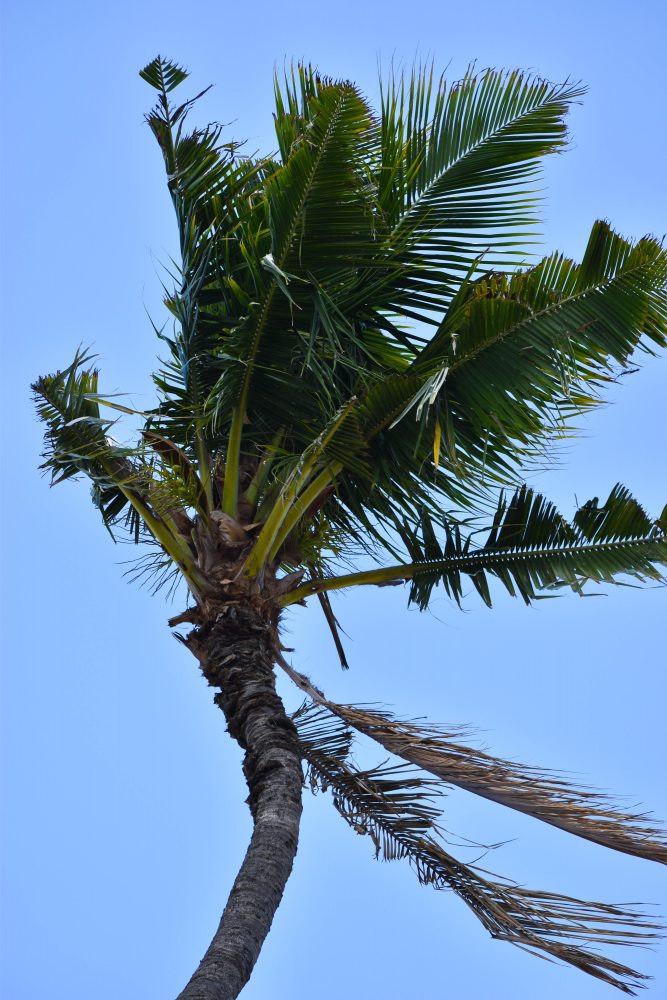
Would-be weavers spilled out of the shade under an open-sided tent at the Arbor Day event at Maui Nui Botanical Garden. Holding coconut leaves, they patiently worked the material back and forth in intricate patterns. At times, chatter came from the tent; other times, it was silent, brows furrowed in concentration. The kumu, master weaver Pōhaku Kaho’ohanohano, moved among the weavers, getting some started while trimming up and tying off the finished creations of others. Novice weavers hugged the kumu, beaming as they walked away with a new hat, bag, bowl, toy, or ornament created from a diminishing pile of leaves.
Coconut weaving is a tradition that dates back thousands of years throughout Polynesia. Coconut palms were first brought to Hawai‘i with the Polynesians. The coconut plant is akin to a pre-contact department store; it can meet needs and wants. Food (coconut meat) and drink (coconut water), material for building shelters, making rope, and weaving mats, bowls, and storage containers all come from the coconut. It’s even used for games and in ceremonial practice; the nut is used in ‘awa ceremony.
But the future of coconuts in Hawai‘i is at risk from a pest accidentally introduced to Hawai‘i. The coconut rhinoceros beetle is spreading on O‘ahu and has begun to reach other islands.

At two inches long, the CRB is a beefy beetle, but it isn’t going to fly interisland on its own. Knowing what you are moving and where it comes from is the first step in preventing the coconut rhinoceros beetle from reaching Maui. By being alert to signs of CRB damage, a vigilant community can help find the pest early and keep it from becoming established.


There are prevention measures in place. In October of 2023, the Hawai‘i Department of Agriculture (HDOA) instituted a temporary, one-year rule prohibiting the movement of high-risk material from O‘ahu to the rest of the state to reduce the risk of spreading coconut rhinoceros beetle. As of October, the following items cannot be moved without a permit: palm plants; decomposing plant material, such as compost, wood, or tree chips; mulch; potting soil; and other landscaping products that may harbor CRB.
These safeguards reduce but do not entirely eliminate the risk of spreading CRB. Here are steps you can take to keep the beetle at bay.
For Maui County, soil, compost, and mulch are the greatest risk. Contractors and landscapers bringing in container loads are doing so by permit, but careful sourcing – checking with the vendor if material came from infested areas – can prevent contamination. Homeowners purchasing bagged landscaping products are advised to be alert as well.
Why? It turns out that bags aren’t much of a barrier to a beetle that can chew through coconut trees. Even if the compost, mulch, or soil wasn’t sourced from an infested area, if bagged soil sits in an infested area, an adult beetle lay eggs in it. The first detection of CRB on Maui was a dead adult found in bagged soil; this was also the suspected vector of CRB found recently on Hawai‘i Island.

Know where your soil and compost are coming from and check for boring holes in bags and larvae. Storing material in closed containers will prevent beetles from laying eggs in them.
The quarantine rule also prohibits shipping coconut plants from O‘ahu that are taller than 4 feet to allow thorough inspection, but the soil in these and all potted plants could be a vector. CRB eggs are only about the size of 1/3 of a tic tac.
As CRB populations on O‘ahu continue to grow, the risk of accidentally transporting the beetle interisland will increase. Visit crbhawaii.org to learn more about distinguishing the Coconut Rhinoceros Beetle from similar-looking species and to see photos of palm damage that can indicate an infestation. Contractors and landscapers can find best management practices to reduce the risk of introducing CRB on the MISC website.
Find details about the interim rule on HDOA’s website. Report suspicious larvae and palm damage through the 643PEST.org reporting system. We need everyone’s kōkua to help protect Maui Countyʻs coconuts, from the royal grove in Kapuāiwa on Molokai to the palms that shade the beaches of Hāna.
Lissa Strohecker is the public relations and education specialist for the Maui Invasive Species Committee. She holds a biological sciences degree from Montana State University. Kia’i Moku, “Guarding the Island,” is prepared by the Maui Invasive Species Committee to provide information on protecting the island from invasive plants and animals that can threaten the island’s environment, economy and quality of life.
This article was originally published in the Maui News on November 10, 2023, as part of the Kia‘i Moku Column from the Maui Invasive Species Committee.
Read more Kiaʻi Moku articles
